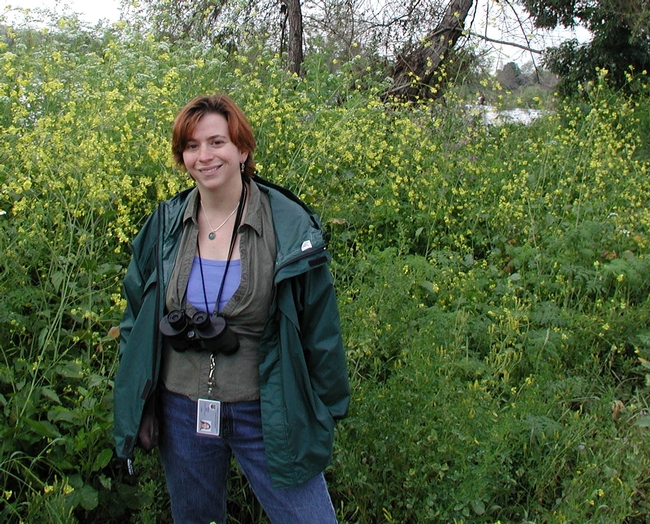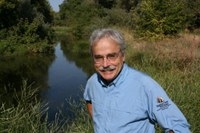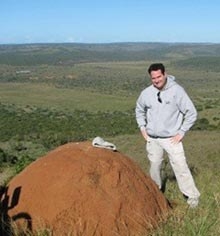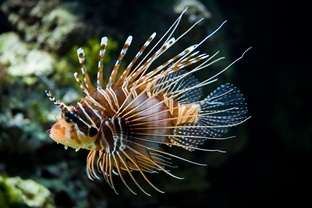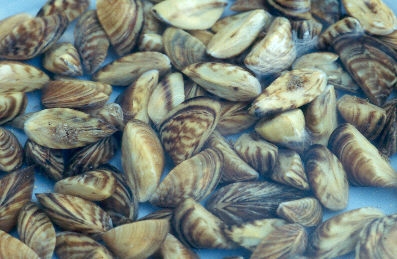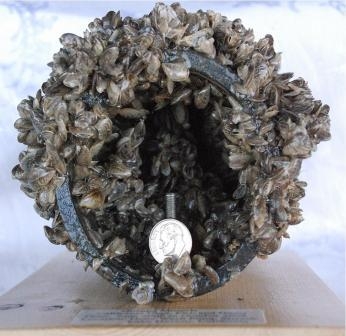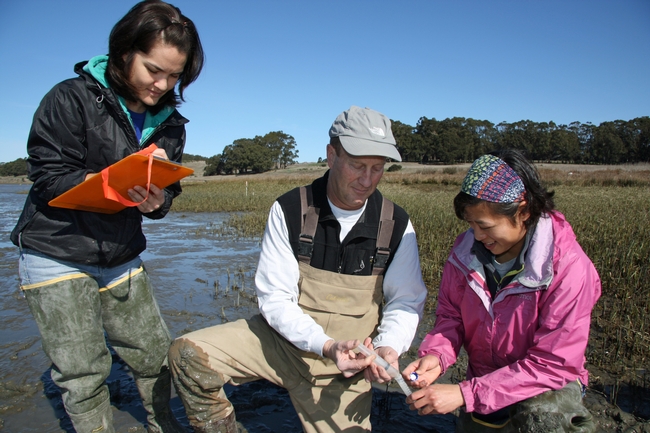Posts Tagged: invasive species
Heavy rains this winter may help native fish in the LA River make a comeback
Biologists believe a high volume of water flowing through the Los Angeles River this winter due to El Niño rain will favor native fish, reported Louis Sahagun in the Los Angeles Times. Native species - who evolved in river systems prone to sudden torrents of water, mud, bolders and debris in winter and pools and damp patches in summer - main gain an edge when the river rages.
Currently, the fish population in the river is almost entirely non-native. Released as bait by anglers, dumped by the city to eat unwelcome species, and aquarium fish set free by their owners now populate the river's waters.
The forecast heavy rains during the 2015-16 winter present an opportunity to determine whether nonnative fish will be washed out of the river and into the Pacific Ocean, giving native fish a new chance to become established.
"If we are ever going to fully understand the ecology of this river, and prospects for the return of species that evolved in it, we have to know first what's in it now, and how well those creatures do in extreme conditions," said biologist Rosi Dagit of the Resource Conservation District.
UC Cooperative Extension natural resources advisor Sabrina Drill was among a group of biologists and volunteers who surveyed the fish in the river in late November with seines, dip nets and rods and reels. After six hours, the team caught about 3,000 talapia, two dozen crayfish, a few hundred mosquito fish, one aquarium species and two Asian freshwater clams.
The research is funded by the Friends of the Los Angeles River.
UC Davis scientists share perspectives on endangered species
You don't have to dig too deep into the scientific literature and popular media to find perspectives on threats posed to biodiversity in California and around the globe. Two UC Davis scientists in the Department of Wildlife, Fish and Conservation Biology have published fresh insights into endangered species in recent months.
Endangered Species Act sets a high standard
Peter Moyle, professor in the Department of Wildlife, Fish and Conservation Biology, is a renowned expert on California's native fish. He used the occasion of the 40th anniversary of the passage of the federal Endangered Species Act (ESA) in December 2013 to size up how the act influenced his own research and how some of California's aquatic biota have fared.
After passage of the ESA, Moyle and his graduate students initially searched for three species they suspected were in trouble: Modoc sucker, rough sculpin and bull trout. They found the sucker in trouble but easy to protect, the sculpin reasonably secure, and the bull trout near extinction in California. It has since vanished.
"As an untenured professor then, I thought it a bit risky to base a career on finding rare fish," Moyle wrote in an opinion piece published in The Sacramento Bee. “So I also undertook a study of Delta and longfin smelt, which at the time were two of the most abundant fish in the Sacramento–San Joaquin Delta.”
Moyle began a monthly sampling program to keep track of smelt populations and other fish in the Suisun Marsh. A few years later smelt counts dropped dramatically. The data eventually led to the U.S. Fish and Wildlife Service listing the Delta smelt as a “threatened” species under the ESA.
His ongoing research has recorded a statewide decline of most native fishes. With other researchers, Moyle has just completed detailed accounts of the biology and status of more than 60 native fishes — all potential candidates for ESA listings. This study will soon be released by the California Department of Fish and Wildlife.
“Most of our recommendations for preventing extinctions call for more and better water for the fish, or at least for protecting existing water they depend on,” Moyle said. “Funny how it almost always comes down to fish needing water.
“The Endangered Species Act sets a high standard in this regard because it not only forbids extinction; it also mandates recovery of each species to a more sustainable state.”
Moyle's opinion piece can be viewed in its entirety here.
Human longevity an indicator of endangered species
Aaron Lotz is a postdoctoral scholar who has previously worked with other UC Davis scientists in the development of conservation and management plans for reptiles and amphibians in California. Recently he was involved in a study published last fall in the journal Ecology and Society on the social and ecological predictors of global invasions and extinctions.
The researchers analyzed data from 100 countries, representing 87 percent of the world's population. They examined 15 social and ecological variables, such as tourism, per capita gross domestic product, water stress and political stability. The study showed that as human life expectancy increases, so does the percentage of invasive and endangered birds and mammals.
“It's not a random pattern,” Lotz said. “Out of all this data, that one factor — human life expectancy — was the determining factor for endangered and invasive birds and mammals.”
New Zealand, the United States and the Philippines had among the highest percentages of endangered and invasive birds. The study has been reported in the Los Angeles Times and other news media. Read more about the study's findings in our news release here. The journal article can be viewed here.
Don’t flush those fish!
Releasing aquarium fish into local waterways — or down the toilet — can damage aquatic ecosystems in a number of ways. The fish themselves can become an invasive species, they can disrupt habitats for other fish and aquatic species, and they may introduce secondary problems such as harmful pathogens or other aquarium species (seaweed, snails) into the waterways.
At least 13 of the 102 aquarium species that are imported into California have been introduced into California marine waters, according to a recent report by Susan Williams, professor in the Department of Evolution and Ecology at UC Davis and a marine ecologist the Bodega Marine Laboratory. These introduced species have a high success rate (69 percent) in establishing themselves.
Two very invasive species — the predatory lionfish and Caulerpa seaweed (aka “killer algae”) — have reportedly come from the aquarium trade. The lionfish, which has established itself along the East Coast where it eats smaller fish and threatens reef ecological systems, has not yet reached California waters, but the Caulerpa seaweed cost California more than $6 million to eradicate from two Southern California lagoons a decade ago.
At least 34 aquarium species were found to be potential invaders in California marine waters.
“Globally, the aquarium trade has contributed a third of the world’s worst aquatic and invasive species,” Williams said. "Lionfish are voracious predators in their native habitats, and in their invaded habitat any predator is a potential threat to the native ecosystem."
Williams’ advice: "To avoid releasing aquarium species into natural water, don’t dump your aquarium where they can become an expensive and harmful pests.”
She said that people should contact the vendor where the fish was purchased or the California Department of Fish and Wildlife to learn how to dispose of aquarium species responsibly.
Learn more:
- Complete UC Davis news release, by Kat Kerlin
- Our AmazingPlanet report
- Environmental News Network report
- Science on NBC News report
Zebra mussels and quagga mussels threaten California water systems
Some of California’s many introduced species — plants, animals, insects, and aquatic organisms — have marked impacts on ecological systems.
Invasive aquatic organisms can impact fish, shorebirds, marsh plants, and other wetland species, and alter functions of lakes, watersheds, floodplains, and coastal ecosystems.
Estuarine ecologist Ted Grosholz, a UC Davis professor and Cooperative Extension specialist in the Department of Environmental Science and Policy, is an expert on invasive species and addresses outreach education on zebra mussels and quagga mussels.
These two invasive, freshwater Eurasian mussels—zebra mussels and quagga mussels — could have a profound impact on California’s lakes and water distribution systems.
Both quarter-sized mussels showed up in California about six years ago. They attach themselves to water conveyance systems — pumps, pipes, dams, aqueducts, and fish hatcheries — and proliferate. According to Grosholz, “our drinking water and agricultural irrigation systems could be shut down quickly by these organisms.”
Los Angeles water districts are coping with the mussels, which are in Southern California watersheds, and reservoirs and canals of the Colorado River. The larval stage of the mussels disperses readily in water, so it gets moved around easily. There is tremendous concern about their potential spread into Lake Tahoe, and they have recently shut down a reservoir near San Jose. These mussels have cost the state tens of millions of dollars.
Zebra and quagga mussels pose a serious ecological threat in California. In the Great Lakes, where they became established 25 years ago, they have removed phytoplankton — a food source for juvenile fish — thereby impacting the food web. They have also concentrated the environmental contaminant botulism, resulting in massive kills of diving ducks and shorebirds.
Aquatic invasive species are moved long distances by ships — in ballast water, hulls and attached to ships’ surfaces. Within California they can be moved by recreational and fishing boats, trailers and other equipment.
“Once aquatic species are introduced, the cat is out of the bag — they spread easily, and they’re very difficult to control,” notes Grosholz.
Since the state doesn’t have the resources to adequately enforce zebra and quagga mussel control, areas such as Clear Lake and Fallen Leaf Lake are establishing local mandatory vehicle and boat inspection programs.
Grosholz works closely with resource agencies and other organizations to develop programs aimed at identifying and reducing the spread of invasive aquatic organisms. “It’s important to increase awareness of these species because they’re such a problem,” says Grosholz. “Their impact on ecosystems is big, and early control is very important.”
To read more about invasive aquatic species, including zebra and quagga mussels, see:
CA&ES Outlook magazine, pages 4–7
Quagga/Zebra Mussel Invasion, UC Cooperative Extension Coastal Resources
Quagga and Zebra Mussels, California Dept. of Fish and Game
Quagga and Zebra Mussel Prevention Program, San Luis Obispo County, California
Quagga and Zebra Mussel, Calif. Dept. of Boating and Waterways
UC Davis scientists to discuss aquatic invasive species and research on endangered fish
A pair of leading UC Davis experts will provide a rare glimpse into efforts to protect California biodiversity at a public lecture May 10, 4–6 p.m., in the UC Davis Conference Center.
Their work is featured in the current issue of “CA&ES Outlook,” the magazine of the UC Davis College of Agricultural and Environmental Sciences. The magazine also examines the work of other UC Davis scientists and students working to conserve biodiversity in California.
The event concludes with a reception and an opportunity to visit with Thompson, Grosholz, CA&ES dean Neal Van Alfen, and other participants. The cost is $15 per person. To register, go to https://registration.ucdavis.edu.
For additional information about this event, please contact Carrie Cloud at (530) 204-7500 or crcloud@ucdavis.edu.


